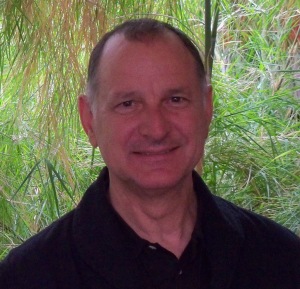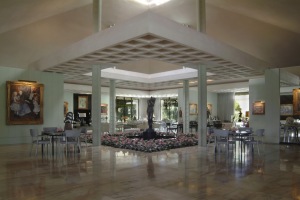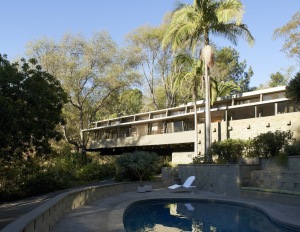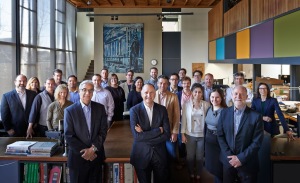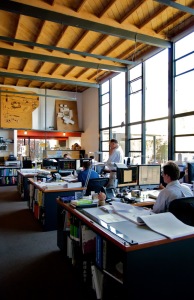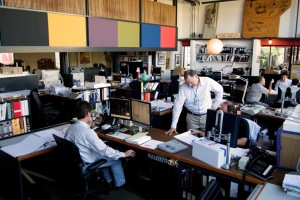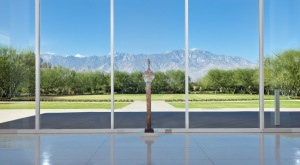Fred Fisher is well known among the cognoscenti of American architecture. In addition to renovating noted buildings by A. Quincy Jones, he has designed numerous projects for the Annenberg philanthropies and buildings for Cal Tech, Colby College, and Princeton University. With the success of the new Annenberg Visitors Center and the renovation of Sunnylands, the Annenberg estate near Palm Springs, the awareness of his talent will spread even further. In 1995, Fisher purchased the office building that once housed the office of A. Quincy Jones and Fred Emmons from Quincy’s widow, Elaine Jones. For several years, he has been involved in projects relating to Quincy’s work, including several residences of varying scales. A few years ago, we met with Fred in his office on Santa Monica Boulevard to talk about this relationship.
Interviewer: I would like to focus on Quincy’s work and your relationship to it. There is your office, where we are seated, and of course there’s Sunnylands, which is the size of a city hall.
Fred Fisher: I’m not sure where I read it, but I think in the course of our research, there was a mention that Ambassador Annenberg actually wanted the home designed in a way that it could be converted into a country club.
Really?
It does have that feeling of a public space. It was conceived for large scale private entertainment.
When Elaine had to leave the Barn, there was a lot of concern over what would happen to the building, which has been a kind of cultural center in Los Angeles since the 1960s. Now it’s part of the Annenberg Foundation?
The Annenberg Foundation bought it from Elaine, and Wallis Annenberg’s daughter Lauren Bon has her own smaller foundation within the Annenberg Foundation that produces artworks and collaborative pieces that she’s involved with. That entity is the user of the building. It’s called the Chora Council.
Can you tell us a little about what she might do there?
Lauren Bon is an artist, and she is involved in producing artworks of others. She sees it as an actively used and publicly engaged studio for art production.
I think she understands the building as part of the Annenberg legacy, which is inextricably linked to Quincy Jones. There is Sunnylands, the Annenberg School of Communications at USC, and now the Barn. I think she sees the Barn as a collection object, as an acquired object in the collection of the Annenberg Foundation, not as a real estate acquisition.
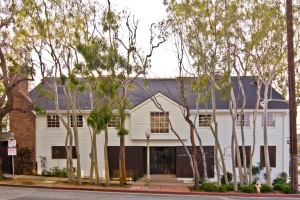 |
| The Barn Photo: Takashige Ikawa courtesy Fred Fisher and Partners. |
Have you changed much at the Barn?
Lauren has been very deliberate about what we call the Hippocratic philosophy of renovation, “first, do no harm.” Basically, we’re just cleaning it up and improving the forty-five year old mechanical and electrical systems. I mean, we’re literally rehabilitating the refrigerator and reusing a range.
I know that range had been broken for a long time. Elaine did replace some of those refrigerator units, and they were very hard to get, now impossible.
We couldn’t find one that matched it that would fit. So that pushed us in the direction of rehabilitating it.
It’s a 45-year old wood building, and it was ready for the care that the Annenberg Foundation is capable of giving. And they’re also capable of owning a piece of property in that location and not ripping it down and using it for the highest and best use. As a house, it only has a couple of parking spaces, which you don’t even want to use, because that’s the courtyard space in the back off the kitchen and studio.
Right. She always parked in front. She used that space as the garden. How did you first become aware of Quincy’s work?
I met him and visited this office shortly after I graduated from UCLA. I had a cursory meeting with him, like many students did, and then that was the only contact I had with either one of them for a while, until after he passed away. I began to see Elaine and meet her in the art world here.
We would see each other at art openings and things like that, and then I got invited to some events at the Barn, and she became a friend. In 1995, I was driving down the street, and I saw the for-sale sign on the office building, and I was shocked that this building would even be on the market. I called Elaine up, and she said that it just came time and that she was going to liquidate the asset.
I knew it was a once-in-a-lifetime opportunity and called in all kinds of favors and scraped, begged, borrowed, and would have stolen the money if necessary to put a down payment on it, and crossed my fingers. This was not a good time economically, but it was just something I knew I had to have. I’m very lucky that we were able to work something out that could work for both of us, and so we bought it, and just did a very light refurbishment before we moved in.
I continued to see Elaine and talk to her, because we’ve been involved in a few other of Quincy Jones’s houses, including Frances Brody’s house. I am also friends with Cynthia Lasker, Frances’ sister-in-law, who had a house designed by Quincy.
Who published that house after you renovated it?
Interior Design.
The one with the red doors?
Rob Maguire, who bought the house at that time, loves the primary colors. We always wondered whether or not Quincy and his partner Fred Emmons had slightly different aesthetics, because Fred’s house in the Palisades is almost like a Marcel Breuer house. The Lasker House was like that too. And yet it had a real formal symmetry to it, which was unlike either one of them. That might have been the influence of Billy Haines. Billy Haines was involved first, as I understand it. The first collaboration with Billy and Quincy was the Brody House. She brought them together, and then they did many more things together, such as the Lasker House and Sunnylands.
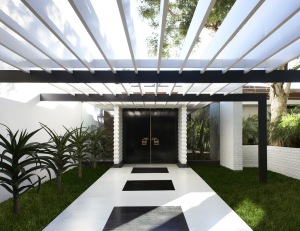 |
| A. Quincy Jones, Sidney F. and Frances Brody House, Los Angeles, California, 1948-51. Photograph by Jason Schmidt, 2012. Courtesy Hammer Museum, Los Angeles. |
What have you come to learn from knowing these buildings so intimately?
His work had an informality. The obvious thing was the openness and the organic quality of a lot of the materials, expression of structure, and openness to the outside environment, although he’s not the only one who was doing that.
But he was unlike some of the other Case Study House architects, closer to Cliff May, in that he had almost a ranch house domestic vernacular. He employed a strong roof with the low-sloped gable and big overhangs. I live in Crestwood Hills, which he planned with Edgardo Contini and Whitney Smith. I don’t live in a Quincy Jones house, but I moved into that neighborhood before I bought this building, pure coincidence, and I now live and work in environments shaped by Quincy Jones.
In Crestwood Hills, the facility with which he and his collaborators fit those houses onto the hillsides and nestled them together kept their privacy and exploited the views; they have a similarity but a variety. It’s a really unique and successful subdivision and a very good example of the best of that era. There’s a kind of warmth and informality that is different than, for example, Gregory Ain’s subdivision in Mar Vista. There is variety there, but less so, and of course, the flat land makes a difference. And then being in this building, Quincy’s office, day after day, year in, year out, it’s had an effect on me. Most significant is the absolute integration of indoor and outdoor space. Here there are the equivalents of horizontal flow to vertical flow.
What do you mean?
I like tall spaces. I had a big loft space before, and when I came in here I thought, boy, am I going to get used to this eight-foot ceiling? But I never even think about it anymore, because the visual flow is horizontal, and there is a lot of it. And then the simple gesture, it’s a rectilinear building, and yet there is one property line, this one, which has a slight angle, and that adds a subtle but significant dynamism to the whole composition, and he plays on that very well.
I also appreciate what I’ve considered to be the Japanese aspect of it. I’m a great lover of Japanese architecture and gardens, and this has that aspect of the intimate gardens, connected to the indoor space. Look at the informal use of organic materials, like the pebble-seeded concrete.
That flows indoors and out.
Right. And the use of the wood paneling, exposed structure, and the indoor/outdoor gardens. I think that’s one of the distinguishing factors of West Coast modernism versus East Coast modernism, the awareness and embracing of Japanese architecture.
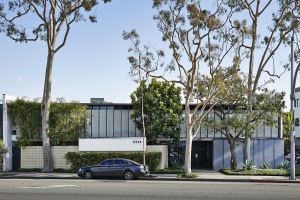 |
| Frederick Fisher and Partners Architects |
You can see that in Quincy’s travel sketches. From working on Sunnylands, what else have you gleaned? Of course, that’s an extraordinary project. While the Brody House is large, Sunnylands is baronial.
Yes, Depending on how many guest wings you figure in, you consider it upwards of 30,000 square feet. It’s hard to exactly know what the program given to him was, and how much was Billy Haines’s thinking, and how much was Walter and Lee Annenberg’s thinking, and how much was Quincy Jones’s thinking. It’s grandiose in a way that none of his other domestic spaces are. The Brody House is sizable, but it’s not grandiose.
The spaces in the Brody house are informal in their planning, whereas Sunnylands is very formal and very grand. Perhaps it had to do with how the Annenbergs imagined who they were and what their position was. Remember, they lived in Philadelphia, and this was their winter house, almost like an extended vacation house, but still a place to entertain on a grand scale.
President Eisenhower, as I understand it, was the first guest. Unlike Jones’s other projects, the house had an intention of social positioning, especially with the idea of a private golf course. You can’t put a bungalow in the middle of a 200-acre site. And yet they didn’t always entertain on a grand scale. Originally, there were only two guest suites, and then there were three more guest rooms added.
I think that the dinners would be at most 24 people, except the famous New Year’s Eve party, where there would be a smaller dinner first and then more people invited for drinks and dancing afterwards.
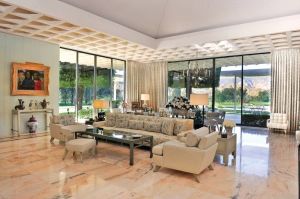 |
| The living room of the estate house, which features many original furniture designs by decorator William Haines. Photo by Graydon Wood. Copyright The Annenberg Foundation Trust at Sunnylands. |
Do you feel that Quincy was able to extend the principles that you see in his more modest buildings to that larger scale?
Nominally yes, but I think essentially not so much. It’s also a different kind of environment out there in the desert. The Annenbergs didn’t live in it five months of the year, because it’s basically uninhabitable out there when it’s 110°. You played golf outside, and you could eat lunch and get in the pool, but the house didn’t embrace the outside in the same way as a part of everyday life, as an extension of the interior spaces. I think it’s more contained, even though there’s lots of glass, and you can look out. It’s a more introverted house.
And more formal?
Very much more formal. The main space is very symmetrical. The different wings, the kitchen, dining, and the guest wing, go one way, and the master suite and office area go another way.
So now that you’ve looked at so many of his projects and worked on all these buildings, has it changed your architecture?
Being in this building has definitely changed my architecture. I’ve always loved California for the connection to Japanese architecture that I mentioned and the Wrightian tradition of use of woods and other organic materials. Being in this building all the time has imbedded some of the ideas we’ve been talking about more essentially than might otherwise be the case, because I live in it. The subtleties of proportions and scale take a while to get into your blood.
Even though this is a commercial building, it really has the scale of a house. It’s attuned me more toward a fine-grained scale of his rooms in relationship to outside spaces: the absolute continuity of materials inside to outside and the particular areas of the sizes of the gardens.
It wasn’t an epiphany or a whole new way of thinking about architecture, but it was an immersion and increasing understanding and absorption of those kinds of relationships and sensibilities.
After looking at a lot of Quincy’s buildings, I would say he seems very focused on the roofline and the experience of the roof visually. Of course, I am not the first to observe this.
Yes, the roof was big. And Sunnylands is a perfect example of that. He liked a statement roof. The new visitors center at Sunnylands is meant to have some of the Quincy Jones DNA, and yet it’s not Quincy Jones. But the thick floating roof is a statement, the way that he liked to do those for even the smaller houses. I wanted to be deferential and not compete with the statement pyramidal roof that he had for the estate, which was definitely driven by the client.
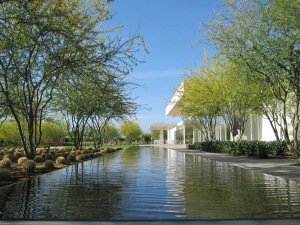 |
| View of the reflecting pools and the rear of the Center, with the Palo Verde trees in bloom. Photo by the Office of James Burnett. Copyright The Annenberg Foundation Trust at Sunnylands. |
Interviewer: While Quincy focused a lot on the roof, he didn’t seem to obsess so much over the elevations. They could be very simple, sometimes even plain. But it was the experience moving through the building that was what mattered. The spatial experience is the thread, not the thing that’s recorded in a photograph that ends up in a magazine. Do you think that’s an accurate assessment?
I haven’t thought about it that way, but I think you’re right. The elevations are not in and of themselves seemingly highly studied compositions. It does have more to do with the views from the inside out. He was very sensitive to, and very good at, movement through a building. Again, our office building is a nicely choreographed set of spaces.
Perhaps this was his greatest talent, the choreography, and then all of the things that influence that: the lighting, the color of the materials, and so forth. Architectural writers focus so much on the object.
It’s so intangible. And you have to experience it to understand it, and so there aren’t that many people who have carefully gone through and experienced those things in order to write about it. It’s one of the hardest things to observe and critique and express about architecture. It’s not seen as a significant part of all architecture, and yet it’s an important part of his work and one of his strengths.
Do you have other aspects, beyond Quincy’s work, that you want to talk about?
As we been having this conversation, I’m reflecting a little bit on how it was a completely unexpected dimension of my career, and yet it’s such an important one. I’m an architect, like most, wanting to do my own work, and I do. And yet this kind of relationship to Quincy Jones has added to it. It has added a fascinating dimension to my practice and a set of fascinating relationships. It is a legacy that I am connected to and feel and obligation to support. I wouldn’t feel that way as much if I didn’t feel empathetic toward his practice, and what he did, and its relevance. I just find it to be one of those surprises and accidents of life that turn out to open up whole new avenues.
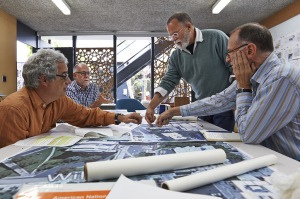 |
| Collaborative design session between FFP Partners and artist Roy McMakin. |
www.fisherpartners.net
www.sunnylands.org
http://www.annenbergfoundation.org/
http://archpaper.com/news/articles.asp?id=5970
